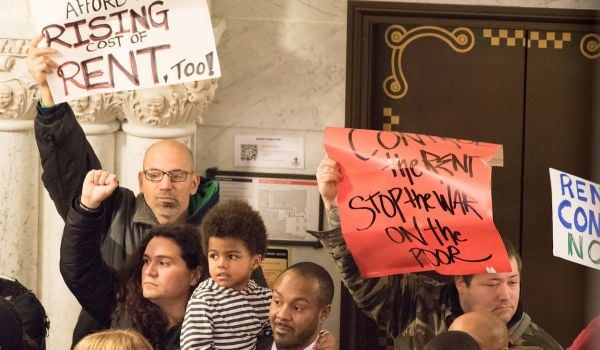Blink, and you might’ve missed it: St. Paul, Minnesota just ended zoning that restricts neighborhoods only to single-family housing. On Wednesday, October 18, the St. Paul City Council voted to change the city’s zoning code to increase neighborhood-scale density across the city. Areas that today only allow for single-family homes will soon allow for at least four units of units of housing per lot.
At first glance, these changes might recall those passed by Minneapolis in 2019, when the city’s 2040 Comprehensive Plan legalized triplexes city-wide. Minneapolis received extensive attention for the changes, as it was a national leader in eliminating city zoning that excluded every housing type except for single-family homes.
Across the Mississippi River, St. Paul has received little attention for their recent zoning reform — no national headlines this time around. There was relatively little conflict over the changes, too. The City Council’s public hearing was filled with testifiers vouching for the benefits of ending such exclusionary and restrictive zoning policies, and only a handful of St. Paul residents testified against these changes.
But while St. Paul’s zoning changes have been much less controversial, and thus received less attention, one key fact is both noteworthy and underrecognized: St. Paul’s zoning changes to low-density neighborhoods were significantly better than those in Minneapolis. This improved policy is closely tied to the increasingly strong agreement around the need for such changes to zoning rules in recent years. In this cross-city comparison, St. Paul can show the promise of a smarter and more thoughtful future for zoning reform.
St. Paulites are deeply indebted to advocates’ previous work in Minneapolis. When Minneapolis’ comprehensive plan initiated citywide zoning changes in 2019, there weren’t model cities who had already made these kinds of changes. Minneapolitan advocates for zoning reform had to fight extremely strong political headwinds around this change.
As a consequence of the fierce resistance to Minneapolis’s potential changes, however, important policy details were lacking. When Minneapolis passed their 2040 Plan, the media coverage
generally paid little attention to regulatory details. However, Minneapolis had to compromise in order to legalize duplexes and triplexes in single-family areas: they restricted the size of these buildings, such that they were no bigger than existing single-family homes. Today, neighborhoods in Minneapolis that were previously zoned only for single-family homes cannot build homes more than 28 feet tall, nor with a floor-area ratio greater than 0.5 (which regulates the amount of floor space relative to the overall lot). Under such rules, you can’t build a three-story building, and a triplex on a standard, 5,000 square foot city lot would have to limit each unit to 833 square feet.
In Minneapolis, this has effectively made duplexes and triplexes impractical to build on many city lots. Only 109 duplexes and triplexes have been built in Minneapolis in the first 2.5 years after their zoning changes passed — and less than half of these new homes in areas that were previously zoned for single-family housing and today have the strictest limits on building form.
Because citywide attention was focused on ferocious battles over the big-picture changes, it was nearly impossible to give the micro-level details the attention they warranted — even though some housing advocates understood that this was a problem.
Contrast this to St. Paul: When the St. Paul City Council had their turn to offer input on the proposed changes, they actually voted to marginally increase the scale of change, increasing height restrictions from 33 to 35 feet in order to more easily accommodate three-story structures. This is the kind of proactive policymaking that undergirds successful zoning reforms.
St. Paul’s changes improve upon the Minneapolis changes along multiple margins. For example, in the new lowest-density districts, height limits are 35 feet, and minimum lot sizes are just 1,500 square feet — opening the opportunity to build homes on smaller lots and greatly reduce land costs. Floor-area ratio isn’t explicitly regulated, and in practice could be significantly higher than 0.5. With these details, the “missing middle housing” that many advocates want to have will be more practical, and will increase the likelihood that St. Paul sees more multifamily housing development in its residential neighborhoods.
At the same time, people in St. Paul are actively pursuing ways to make these zoning changes more equitable. For example, a local nonprofit has combined research and a pilot program focused on creating opportunities for low-income residents to own 2-4 unit multi-family homes. These kinds of opportunities that focus on assisting marginalized residents are deeply complementary to zoning reforms that allow for more housing. These synergies are also better enabled by healthier politics around changing city zoning.
When we move on from over-the-top fear mongering about the effects of zoning reform, political and discursive space opens up to get the details right. The Twin Cities have begun to develop a strong consensus that allowing more housing of different types is a key component to attaining housing affordability and equity. Thus, city staffers and elected officials have put their efforts into making sure changes would best achieve those crucial goals.
The Twin Cities are far from alone in pursuing zoning changes. In the past few years, many cities have passed zoning reforms to encourage more housing; so have many states. Even the federal government has gotten involved, with new programs nudging localities to improve their housing regulations. More than ever before, now is the time for policymakers to turn their attention to nailing the details of zoning reforms — and they’re finally starting to get the room to do so.
This article is part of Backyard, a newsletter exploring scalable solutions to make housing fairer, more affordable and more environmentally sustainable. Subscribe to our weekly Backyard newsletter.
Zak Yudhishthu is a student and writer in Saint Paul, Minnesota, focused on housing and urban policy.


















